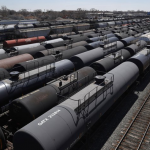The oil market has had a month of significant recovery. Since the historic cuts by Saudi Arabia and Russia took hold, and the US shale industry began to contract, crude prices have jumped around 70 percent and seem to have established a “floor” at $30 a barrel and a trading range of around $35.
That is nowhere near enough for oil-producing states that count on energy revenue to fund their budgets, but it is a move in the right direction after the carnage of “Black Monday.” It shows that the oil market can be at least partly regulated by supply actors, even in the midst of the most savage demand destruction in history because of global economic lockdowns.
The recovery was mainly due to signs that the energy-guzzling economies of East Asia — principally China, Japan and South Korea — were resuming economic activity at a faster-than-anticipated rate, and also the realization that “tank top” — exhaustion of the world’s storage capacity — was not going to happen.
The big storage facility at Cushing, Oklahoma, was never at serious risk of breaching capacity, and demand for expensive floating storage is declining.
There is still a lot that could go wrong like a serious second wave of coronavirus or a complete rupture in trade relations between the US and China but, barring these, the outlook for oil is better than you might have reasonably expected a month ago. Analysts are looking at an average of around $35 this year and perhaps more than $50 in 2021.
A lot is riding on the OPEC+ deal led by Saudi Arabia and Russia. This will be the subject of talks at the OPEC meeting next month, when participants will have to decide whether to reduce the level of cuts from 23 percent to 18 percent of output. There is a considerable body of opinion within the organization that the 23 percent level should be adhered to for an extended period. Saudi Arabia has already gone even further than that, with an extra one million barrels per day reduction, backed by other Gulf producers.The other significant variable in the OPEC equation is the level of compliance with the cuts. Russia, which has long argued that big cuts were impossible for its oil business because of geological and climatic reasons, appears to have found a way around those challenges.
For Iraq, Nigeria and Libya, the financial situation is dire enough to distract them from the precise terms of the OPEC+ deal and maybe tempt them to sell as much as possible while prices hold.
But the big imponderable is in US shale. On all the indicators — well shut-ins, fall in rig count, job losses and bankruptcies — the past month has been savage, especially in the Texas heartland of the industry, as the price of West Texas Intermediate fell through the floor.
Rising prices change the economics again. Not many shale operators are viable at $30, but as the price creeps upward it makes sense for them to start thinking of pumping again. Upward of $40, there could be a renewed surge in shale production.
This would drop a spanner in the works of the global industry. It would make no sense at all for Saudi Arabia to continue with its market-changing cuts, which are exacting a big price in terms of lost revenue, if the US was swamping the world with oil again. The battle for market share — with the Kingdom turning the pumps full throttle again — would be back on.
We’re not there yet by any means. Much depends on whether President Donald Trump’s administration adds the oil industry to its list of sectors needing support in the big pandemic support package struggling through Congress. The Democrats don’t like that idea but, in an election year and with promises of environmental concessions by Big Oil, they might be persuaded.
Even as the oil industry congratulates itself on its policy response to the pandemic, it has to be aware that a new oil price war is just a few dollars per barrel away.







